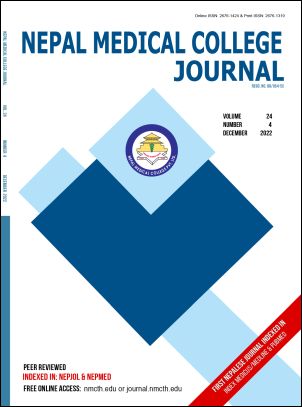Biochemical and Hemodynamic Characterization of Nephrolithiasis Patients visiting National Transplant Centre, Bhaktapur, Nepal
DOI:
https://doi.org/10.3126/nmcj.v24i4.50577Keywords:
Biochemical, chronic kidney disorder, hemodynamics, nephrolithiasis, types of stoneAbstract
In present scenario, nephrolithiasis (renal stones) are more prevalent and highly related with morbidity worldwide. The aim of the study is to associate different biochemical and hemodynamic parameters of renal stones and to see post-operative outcomes. Hundred patients from January 2019 to January 2021 having renal stone in ultrasonography at Shahid Dharmbhakta National Transplant Centre Bhaktapur are included in the study. All variables are measured following the standard protocol. Nephrolithiasis was found to be frequent in male population (60%) who has a habit of regular alcohol intake (65%, p=0.009) and mixed dietary habit (mostly non-vegetarians) (92%, p= 0.042). Calcium oxalate either solely (21%) or mixed type (41%) were higher in proportion. The most common dyslipidemia in recurrent cases were hypercholesterolemia and increased LDL (p<0.001). The significant increase in serum urea (p=0.006) and creatinine (p=0.004) signify decrease in eGFR (p=0.007). Serum creatinine with IQR (1-2.5 mg/dl) was noticed significantly higher in others stone group V in contrast to mixed calcium containing stones group IV. Hydronephrosis was seen in 96% of patient, 7% developed post-operative complication comprising 57% haematuria, 28.5% wound infection and 14.5 % chest infection. Biochemical and hemodynamic parameters should be incorporated in nephrolithiasis to rule out risk of dyslipidemia, chronic kidney disorder and stratify the risk group based on stone composition.
Downloads
Downloads
Published
How to Cite
Issue
Section
License
Copyright (c) 2022 Nepal Medical College Journal

This work is licensed under a Creative Commons Attribution 4.0 International License.
This license enables reusers to distribute, remix, adapt, and build upon the material in any medium or format, so long as attribution is given to the creator. The license allows for commercial use.




